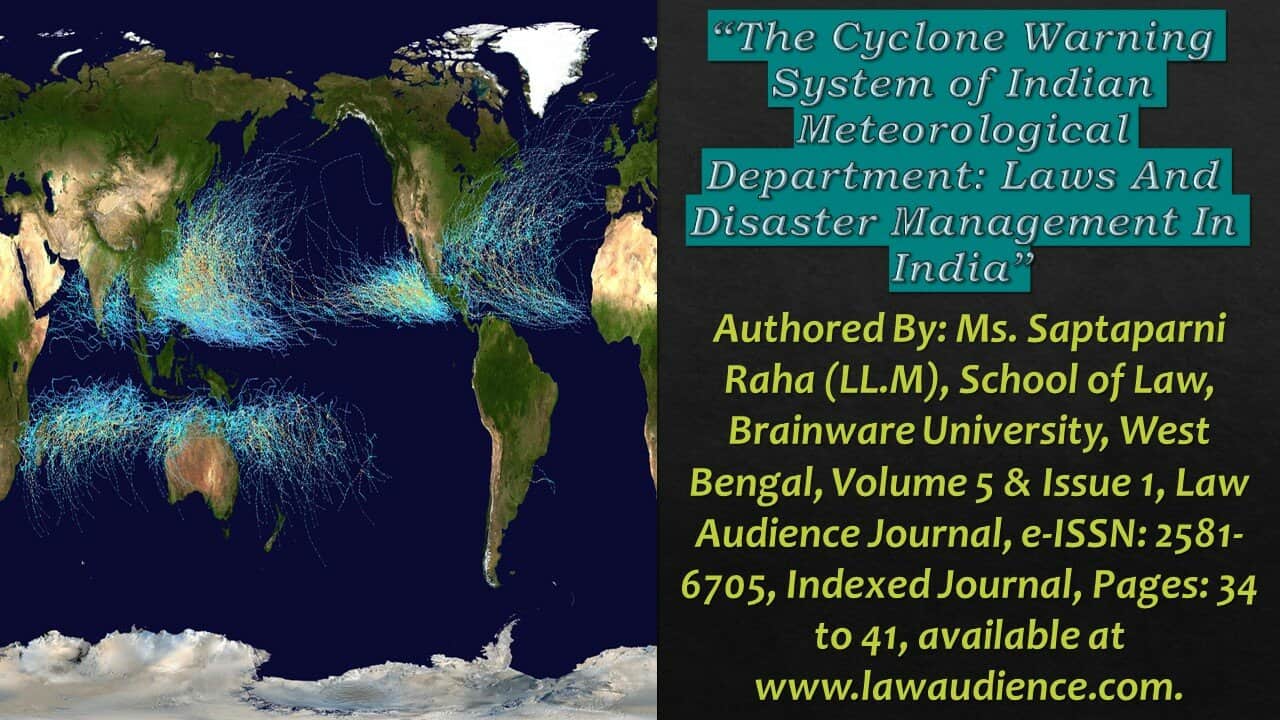Click here to download the full paper (PDF)
Authored By: Ms. Saptaparni Raha (LL.M), School of Law, Brainware University, West Bengal,
Click here for Copyright Policy.
ABSTRACT:
“Legal frameworks play a pivotal role in any aspects around in our society. This is the main reason to constitute a modern democratic political system based on a written Constitution. Emerging issues that are not mentioned in the constitution for some reasons have been provided a basis to enact new legislation. One such issue in our country is disaster management. Being the most disaster-prone country, it is not mentioned in the Constitution. There are two types of disasters, natural and man-made. One of the natural disasters is cyclones. The author of this article shall discuss the legal and institutional frameworks to protect India from this natural disaster”.
Keywords: Legislation, Constitution, Cyclone, Disaster, Institutional Frameworks[1].
I. INTRODUCTION:
The word meteorology means the science of the atmosphere and its various phenomena. It also deals with weather and weather forecasting. Seismology, Geography, Geology, etc. are also part of meteorology. Indian meteorological department is a government agency that deals with India’s meteorological conditions. This agency was birth in 1875 as the national meteorological service in India. Indian Meteorological department has the administrative responsibilities of a department under the supervision of the Ministry of Earth Sciences of the Indian Government. The headquarters of this department is in New Delhi. The meteorological department observes and provides current information regarding weather forecasts which is very important for the activities of irrigation, agriculture, aviation, offshore oil exploration, and so on. It warns against severe weather phenomena such as tropical cyclones, dust, storms, heat, cold weaves, etc. IMD also provides the met related statistics required for agriculture, industries, water resources management, etc. This agency also conducts research in meteorology and allied subjects. Indian Meteorological Department has the following organs as Indian Meteorological Department and Agriculture, the Indian Meteorological Department and Aviation, the Indian Meteorological Department, and Water Issues.[2]
II. CONSTITUTION OF INDIA:
Being the lengthiest constitution, it does not have any explicit provision for disaster management. It may have reasons to not include a subject like a disaster management in the constitution. Those expected reasons are; 1) Being the grundnorm according to the jurist kelson, it is the basis of other legislations and directed legislative, administration of different strata of governments. 2) During the time of the inception of the Constitution, makers do not find any significance to insert a subject like a disaster into the constitution as the environment was in a much better condition than now. Though industrialization and its effect change our environment and we have seen many amendments, so now it must be taken into consideration. 3) India already has a colonial framework like famine code to fight against natural disaster and the existence of administrative machinery where national leaders have to conduct the rescue and operations so it failed to secure a position in our Constitution.
However, as a subject of legislative competence the disaster management Act impliedly a part of Article 248 of the constitution dealing with the residuary part of the legislation. This empowers parliament to make laws regarding any matter not mentioned in the concurrent or state list. Though Article 248 extends its jurisdiction of a subject like disaster management, do not find any place in any list given in the seventh schedule of the constitution. Entry 56 of the union list envisages the legislative power of central government over the ‘regulation and development of inter-state rivers and river valleys to the extent to which such regulation and development under the control of the union is declared by Parliament by law to be expedient in the public interest.’ Entry 17 of List II (state list) provides that “states can legislate on the subjects of ‘water, that is to say, water supplies, irrigation and canals, drainage and embankments, water storage, and water power subject to the provisions of entry 56 of List I”.[3]
III. DISASTER MANAGEMENT ACT, 2005:
The Disaster Management Act, 2005 was enacted on 26th December. This Act was the effect of the 2004 tsunami when India lost thousands of lives. The Government passed this Act to manage the disasters efficiently and take certain measures to mitigate strategies, capacity building, and related matters. The head of the National Disaster Management and the nodal agency is Prime Minister Narendra Modi. The Nodal Agency holds the mandate to lay down policies for disaster management. This Act aims to manage disasters which includes preparation to mitigate strategies, capacity building, and a lot more. The Ministry of Home Affairs has been designated as the nodal ministry by this Act that is responsible to look after the overall national disaster management in the country. This Act also made provisions for financial mechanisms which include the creation of funds for an emergency response like the National Disaster Response Fund. The National Disaster Management Authority or NDMA established under this Act is the nodal central body for disaster management coordination. Our honorable Prime Minister is the chairperson of it. This authority has the responsibility to frame the policies, plans, and guidelines for disaster management to ensure effective and strong response during any disaster.
Another committee established under this Act is the National Executive Committee or NEC to assist NDMA which prepares the National Disaster Management Plan for the whole country. Then for the state and district levels, the Act created SDMA and NDMA to draw the disaster plan for district and state levels. The Act has also created The National Disaster Response Force who will directly respond against the threat of disasters and calamities. The Act empowers NDMA and the Central Government to implement the laws properly. This Act allows the Central Government to issue instructions to any authority anywhere located in India to assist and contribute to disaster management. If the Central Government fails to follow such directions it will lead to the violation of this Act. According to Section 51 if anyone refuses or fails to follow orders is liable for punishment with imprisonment which may last for one year or fine or both. Section 52 of this Act prescribes punishments for the person if he or she makes a false claim to gain relief benefits. Section 54 of this Act prescribes imprisonment of one year or a fine if someone is liable for a false warning about the severity of a disaster.[4]
IV. AREAS MOST VULNERABLE TO CYCLONES IN INDIA:
According to the India Meteorological Department, there are 12 districts located on the east coast that are very highly prone and 41 highly prone to cyclones. Union Territories and 13 coastal states are affected by Tropical Cyclones. West Bengal, Andhra Pradesh, Odisha, Tamil Nadu, and one Union Territory state Puducherry are located on the east coast, and Gujarat on the west coast is more vulnerable. Nellore, East Godavari, Krishna in Andhra Pradesh, Yanam in Pondicherry, Balasore, Bhadrak, Kendrapara, Jagatsinghpur in Odisha, South and North 24 Pargana, Medinipur, Kolkata in West Bengal these 12 areas are named as the cyclone hazard-prone districts by IMD, among 96 districts out of those 72 touches, the Indian coast and 24 are close to the coast. Among those 96 districts, 30 districts are moderately prone and 13 are less prone to cyclones.[5]
V. IMPACT OF CYCLONES ON SOCIETY:
There is no doubt that there is a severe impact of a cyclone as per its speed and duration. The cyclone affects the society, economy, environment, and geography of any place where it comes. It destroys the electricity pole and mobile towers so people affected by the cyclone cannot do anything. People staying in the affected area cannot have anything for so long because of the destruction. They cannot stay connected with their close relatives because of the unavailability of network connections. People spend their life near the death toll which affects their physical as well as mental health.
V.I GEOGRAPHICAL IMPACT:
The main geographical impact of any cyclone is sand blowing due to the high wind velocity; it is not preceded by rainfall but by the sand on the beach above the high tide level. This sand moves in the direction of the wind so sometimes it spreads over the agricultural land. This reduces the fertility of the soil and after that, it suffers from unproductiveness for a considerable period. Cyclones also cause a change in channel characteristics by the sudden inflow of a large volume of water with a high velocity. Erosional processes are visible during the tidal surge due to the forces, as a result, the point bars of the river may be completely detached from the banks.
V.II FINANCIAL IMPACT:
Cyclones destroy buildings, offices, electric poles, mobile towers, etc. Many people lose their goods and necessary items. This brings a devastating impact on the country’s economy. Recently almost 9,887 people were affected by cyclone Amphan which caused a loss amounting to $ 4.44 billion.[6]
VI. CYCLONE DISASTER MANAGEMENT IN INDIA:
India has taken the following measures proposed by UN-HABITAT given below
VI.I HAZARD MAPPING:
Hazard Mapping helps to predict the vulnerable areas affected by storms by mapping the pattern of old cyclones by using their wind speed, areas affected, etc.
VI.II LAND USE PLANNING:
The key activities and settlements can be avoided in the most vulnerable areas by the effective implementation of land use planning.
VI.III ENGINEERED STRUCTURES:
These structures stand with the wind forces to mitigate the losses, so the public infrastructure of the country should be designed by keeping in mind the hazard mapping of the cyclone.
VI.IV FLOOD MANAGEMENT:
Cyclonic storms bring heavy rain which causes floods. So, drainage systems should be well structured to mitigate floods.
VI.V CYCLONE SHELTERING:
The construction of cyclone shelters is very important at the national, state, and regional levels to help the vulnerable community from cyclones. It shall be constructed by considering the density of the population, and distance from the affected areas of the past.
VI.VI VEGETATION COVER IMPROVEMENT:
Vegetation cover needs to be improved to increase the water infiltration capacity. Plantation of trees in rows, plantation of a coastal shelterbelt, and mangrove shelterbelt can help to break the wind force.
VII. INDIA’S INITIATIVE:
India has initiated the National Cyclone Risk Mitigation Project intending to undertake structural and non-structural measures to mitigate the effects of cyclones for coastal states and UTs of India. India gets financial help from the World Bank for this project. The National Disaster Management Authority implements this project. Integrated Coastal Zone Management is another project in India which has been drafted in August 2019. It is the draft of the Environmental and Social framework. This project was initiated to bring a comprehensive plan to manage coastal areas. Colour coding of Cyclones is weather warnings initiated by IMD to alert people ahead of natural disasters. IMD used four colors green, yellow, orange, red, etc.
VII.I MANGROVE PLANTATION:
Mangroves help to mitigate tsunamis and soil erosion. So, mangroves shall be planted to mitigate the cyclone.[7]
VII.II ABOUT THE NEW CYCLONE WARNING SYSTEM:
Seven established cyclone warning centers cover the east and west coasts of our country. Among these three are located at Chennai, Mumbai, and Kolkata, and the rest centers are located at Ahmedabad, Thiruvananthapuram, Visakhapatnam, and Bhubaneswar. The art of tools for the cyclone warning system has been prepared by India Meteorological Department and has demonstrated its capability to provide early warning for cyclones with high precision. It has been recognized as a very effective tool and earned respect globally and nationally. Now by the passing of years, this system has improved its accuracy so the loss of life due to cyclones has drastically reduced in recent years.[8]
VII.III IMPACT-BASED FORECASTING:
A dynamic, impact-based cyclone warning system has been launched by IMD on an experimental basis in Chennai. Now they can plan better during heavy rain because they will be equipped with details that will help to mitigate traffic disruption. It would be more of a multi-disciplinary approach and the IMD will get inputs from CFLOWS a web-based application developed by the State government. As a result, they can predict floods in a specific location. A denser automatic rain gauge network has also been created by the department by adding 25-30 ARGs in and around Chennai. Now cast weather prediction service will forecast weather for the next two or three hours to 55 stations in 37 districts by the department.[9]
VIII. CONCLUSION:
Nowadays the number of cyclones, earthquakes, and other natural disasters has increased a lot. The main reason behind all these natural disasters is the continuous environmental degradation and climate change. The biodiversity and the ecological circle have been destroyed due to global warming. So, we need to protect our environment first. The destruction of the environment shall be included as a penal offense now. Other environmental laws should be implemented properly. So that we can protect our environment from further destruction. But before all that people should now at least understand the importance of the environment and shall obey the laws because the law cannot do anything alone. We as responsible citizens of India are duty-bound to protect the environment and respect the law then only it would be possible to mitigate cyclones, earthquakes, and other natural disasters.
Cite this article as:
Ms. Saptaparni Raha, “The Cyclone Warning System of Indian Meteorological Department: Laws And Disaster Management In India”, Vol.5 & Issue 1, Law Audience Journal (e-ISSN: 2581-6705), Pages 34 to 41 (27th February 2023), available at https://www.lawaudience.com/the-cyclone-warning-system-of-indian-meteorological-department-laws-and-disaster-management-in-india/.
References & Footnotes:
[1] Rajendra Kumar Pandey, Legal Framework of Disaster Management In India, ILI Review, Winter Issue 2016, https://ili.ac.in/pdf/p13_rajendra.pdf.
[2] Byjus: India Meteorological Department(IMD), byjus, https://byjus.com/free-ias-prep/cyclone-disaster-management/.
[3] Rajendra, supra note 176.
[4] Pbns: Disaster Management Act 2005: Provisions And Punishment (June 6,2021), https://newsonair.com/2021/06/disaster-management-act-2005-provisions-punishment-explained-2/.
[5] Pti: 12 Districts Very Highly Prone To Cyclone (Jul 12 July, 2015, 11:13 AM), https://economictimes.indiatimes.com/news/science/12-districts-very-highly-prone-41-highly-prone-to-cyclones-study/articleshow/48039511.cms.
[6] Soumya Bhowmik, Impact of Cyclone on Bengal Economy, https://www.orfonline.org/expert-speak/cyclone-amphan-storming-bengals-economy-66916/.
[7] Byjus: Cyclone Disaster Management in India, https://byjus.com/free-ias-prep/cyclone-disaster-management/.
[8] Ministry of earth science: Cyclone Warning System, (March 16,2021), https://www.pib.gov.in/PressReleasePage.aspx?PRID=1705151.
[9] Vinson Kurian: IMD Launches Impact Based Cyclone Warning System (12 October,2020), https://www.thehindubusinessline.com/economy/agri-business/imd-launches-impact-based-cyclone-warning-system/article32834746.ece.



